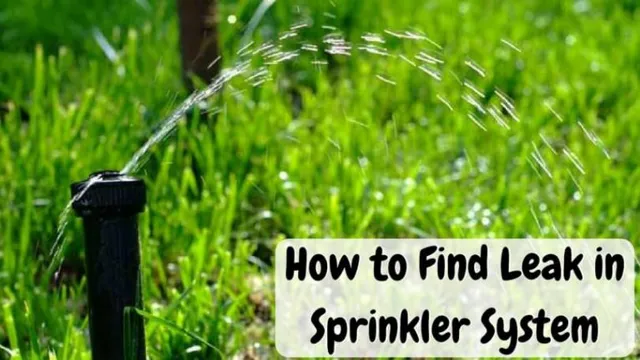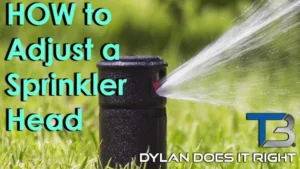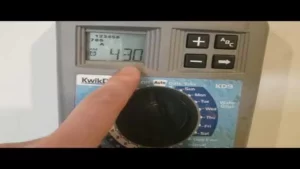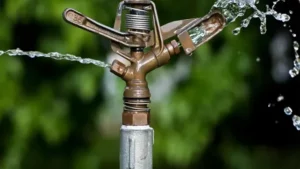Picture this: it’s a hot summer day, and you’re sitting in your backyard, admiring your lush green lawn and the beautiful flowers in your garden. But, as you look around, you notice that certain areas aren’t as healthy-looking as others. Your sprinkler system has been on the fritz lately, and it’s starting to show.
Moreover, your water bill has skyrocketed, and you can’t figure out why. The culprit may very well be a leak in your sprinkler system, and while it may seem like a minor issue, it can cause significant damage to your landscape and your wallet. In this blog post, we’ll discuss how to detect a leak in your sprinkler system and what you can do to fix it.
Signs of a Sprinkler System Leak
If you notice your grass or plants looking a little too green, or maybe there are soggy areas in your yard that haven’t dried up in a while, it could be a sign of a sprinkler system leak. Additionally, if your water bill is higher than usual, there’s a good chance that water is being wasted due to a leak. You may also notice low water pressure or an uneven distribution of water around your yard as other signs.
One way to check for a leak is to turn off the system, wait a few hours, and then check the water meter. If it has moved, there is a leak somewhere. Another option is to inspect the sprinkler heads for any damaged or broken parts.
It’s important to address a leak as soon as possible to avoid further damage and unnecessary water waste. Regular maintenance and inspection of your sprinkler system can help prevent leaks from occurring in the first place.
Increase in Water Bill
If you’ve noticed a sudden increase in your water bill, it could be a sign of a sprinkler system leak. While it’s easy to overlook, a leaky sprinkler can cost you hundreds of dollars in wasted water and damage to your landscape. To determine if your sprinkler system is leaking, look for wet or saturated areas around the lawn or garden, as well as water pooling on sidewalks or driveways.
Additionally, you may notice mysterious patches of green grass or unusually dry patches in other areas. If you suspect a leak, turn off the sprinkler system and check each element to see if there is any visible damage. In some cases, a small fix like a broken nozzle may be all that’s needed, but larger leaks may require professional help.
Ignoring a leak can cause more damage in the long run, so it’s important to address it as soon as possible to save money and ensure the longevity of your sprinkler system.
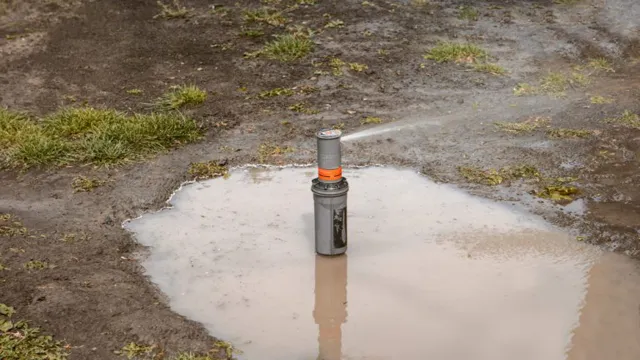
Mushy or Soggy Grass
If your grass feels mushier than usual, you may have a leak in your sprinkler system. Some signs of a leak include soggy patches of grass, a sudden increase in water bills, and a decrease in water pressure. A leak not only wastes water but can also lead to mold and mildew growth, which can harm your lawn’s health.
To identify the source of the leak, turn off your sprinkler system and inspect the pipes and valves for visible signs of damage or corrosion. If you’re unsure about how to proceed, it’s best to call a professional to locate and repair the leak. Once the leak is repaired, you’ll be able to enjoy healthy, green grass without the worries of mushiness or soggy spots.
Remember, regular maintenance and inspections of your sprinkler system can prevent leaks and save you money in the long run.
Pooling Water Around Sprinkler Heads
If you notice water pooling around your sprinkler heads, it may be a sign of a leak in your sprinkler system. This can be caused by a variety of reasons, including damaged pipes, faulty valves, or broken sprinkler heads. Not only can this lead to water waste and higher water bills, but it can also damage your lawn and landscaping.
You may also notice dry spots or uneven watering if there is a leak in your system. It’s important to have a professional inspect and repair your sprinkler system if you notice any of these signs. Ignoring the issue could lead to even bigger problems and expenses down the line.
Don’t let a leaky sprinkler system ruin the beauty of your lawn; take action and fix the issue today!
Steps to Detect a Sprinkler System Leak
Having a sprinkler system is great for keeping your lawn and garden healthy, but a leak can cause not only a higher water bill but also damage your property. So how do you detect a leak in your sprinkler system? Here are some steps to follow. First, you will need to turn off the water supply to your sprinkler system and make sure the valves are closed.
Next, inspect the sprinkler heads and look for any signs of water pooling or bubbling up. Check all the connections and pipes for any obvious damage or signs of water. Then, turn the water back on and run the system as usual, paying close attention to any areas where you suspect a leak.
Finally, if you still can’t locate the source of the leak, consider hiring a professional to come in and inspect the system with specialized equipment. By taking these steps, you will be able to catch any leaks in your sprinkler system and prevent further damage to your property.
Check for Over-Watering
If you’ve noticed that your lawn is staying soggy or there are visible puddles of water in your yard, it might be a sign of over-watering. One of the most common causes of an overwatered lawn is a sprinkler system leak. Luckily, detecting a sprinkler system leak is easier than you might think.
First, turn off your sprinkler system and wait for a dry day. Depending on your system, this might involve turning off the main water supply or simply the power to your controller. Then, check for any visible leaks or signs of damage to your sprinkler heads, pipes, or valves.
You can also do a simple soil test by digging down about 6 inches in several spots around your lawn. If the soil is consistently very wet or there is standing water in the holes you’ve dug, it could be a sign of a leak. Finally, check your water bill over a few months.
If you notice a sudden increase in water usage without any other explanation, it might be due to a sprinkler system leak. By taking these steps, you can detect a sprinkler system leak early on and prevent further damage to your lawn and wasted water.
Inspect the Sprinkler Heads
One of the essential steps to detect a sprinkler system leak is to inspect all the sprinkler heads. These heads may take a beating from lawnmowers or other equipment, causing them to break. A broken sprinkler head can cause a leak and wastes massive amounts of water if left undetected.
Check each head for possible damage such as cracks, chips, or missing parts. Look for signs of water spraying from the head, which could indicate a torn diaphragm or a clogged nozzle. If you notice any of these issues, it’s essential to replace the broken sprinkler head or repair the damaged parts.
Remember, inspecting and maintaining your sprinkler system is crucial to keep your lawn lush and green while conserving water.
Perform a Visual Inspection of the System
Performing a visual inspection of your sprinkler system is crucial to detecting a leak and ensuring it functions properly. The first step is to check for any water puddles or wet spots around the system. This can indicate a leak in the pipes or valves.
Next, inspect the sprinkler heads and look for any signs of damage or wear, such as cracks or broken parts. A damaged sprinkler head could be causing water to spray in the wrong direction or not at all, leading to water waste. Inspect the pipes and valves for signs of corrosion, rust, or any protruding objects that could cause damage.
Lastly, check the pressure gauge to ensure it is within the recommended range. By following these steps, you can detect a sprinkler system leak before it leads to water waste, high water bills, and damage to your lawn or landscape.
Utilize a Pressure Gauge or Leak Detector
As a homeowner or property manager, detecting a leak in your sprinkler system is important not just for reducing water waste but also for ensuring the system is working efficiently. One simple and effective way to detect a leak is by using a pressure gauge or leak detector. First, turn off the water supply and attach a pressure gauge to the system.
Check to see if the pressure reading remains steady—if it drops, there may be a leak. Alternatively, you can use a leak detector to listen for the sound of running water underground near the sprinkler system. By pinpointing the location of the leak, you can quickly address the issue and prevent further water waste or potential damage to your landscape.
Don’t let a leak go unnoticed – a simple pressure gauge or leak detector can help you detect the problem and save you time and money in the long run.
Fixing the Sprinkler System Leak
Having a leak in your sprinkler system can be frustrating and expensive if not detected and fixed early. The good news is that there are some telltale signs of a leak that can be easily spotted and addressed. The first thing to do is to check your water bill and see if there is an unexplained increase in usage.
If so, this could be a sign that there is a leak in your system. You may also notice wet spots or puddles in your lawn, or even water bubbling up from underground. Another indication could be a drop in water pressure or a strange sound coming from your sprinkler lines.
Once you have identified a leak, it’s important to fix it quickly to avoid further damage. This can be done by repairing or replacing the affected pipe or sprinkler head, or by adjusting the pressure and flow of the water in your system. By staying vigilant and addressing any leaks early on, you can ensure that your sprinkler system remains efficient and effective for years to come.
Locate the Leak
When it comes to fixing a sprinkler system, locating the leak is the first step. It may seem like a daunting task, but it’s actually easier than you might think. First, turn on your sprinkler system and look for any obvious wet spots or areas with standing water.
This could be a sign that there’s a leak in that spot. If you don’t see anything obvious, you can try using a probe rod to poke into the ground around your sprinkler heads and pipes. If you hit an area where the soil is softer or moister than the surrounding soil, this could indicate a leak.
Once you’ve located the leak, the next step is to repair it. This could involve replacing a broken sprinkler head, tightening a loose connection, or replacing a damaged pipe. Whatever the issue may be, it’s important to address it quickly to prevent any further damage to your lawn or waste of water.
By taking the time to locate and fix leaks in your sprinkler system, you’ll not only save money on your water bill but also ensure that your lawn stays healthy and green.
Dig Up the Affected Area
If you think you have a leak in your sprinkler system, the first thing you need to do is locate the affected area. Once you have identified the spot, it’s time to dig up the ground around it. The reason for digging up the area is to expose the damaged pipe or valve and allow you to fix it.
This can be a time-consuming task, but it’s essential to prevent further damage to your sprinkler system. If you neglect to fix the leak, it could cause water waste, damage to your lawn, and eventually, increase your water bill. To find the affected area, you can start with the sprinkler heads as they are often the primary source of leaks.
Turn on your watering system and look for any sprinkler heads that are spraying water in the wrong direction or at a lower pressure than usual. If you notice any wet patches in your lawn or hear a hissing sound from your sprinkler valves, they can be signs of a leak. After locating the leak, you can now dig up the ground around it and turn off the water supply to prevent any further water loss.
In summary, fixing the sprinkler system leak can be a challenging task, but it’s necessary to prevent further damage. Digging up the affected area is the first step to identifying and fixing the leak. If you’re unsure about how to proceed, you can always call a professional to help with the repair process.
Remember to turn off the water supply before digging up the ground to prevent any water loss. With a little effort and time, you can fix your sprinkler system and get your garden back to a lush, green state.
Repair or Replace the Broken Pipe or Sprinkler Head
If you notice that your sprinkler system is leaking or not working correctly, the first step is to determine the cause of the problem. Oftentimes, leaks are caused by a broken pipe or a damaged sprinkler head. Depending on the severity of the leak, you may be able to fix it yourself or you may need to call in a professional.
If you do decide to tackle the problem yourself, the first step is to locate the source of the leak. This can be done by inspecting your sprinkler lines and heads for any visible damage or by using a pressure gauge to check for any drops in water pressure. Once you have identified the cause of the leak, you can decide whether to repair or replace the broken pipe or sprinkler head.
In general, it is always best to opt for a replacement if the damage is extensive or if the component is past its lifespan. Not only will this ensure that your sprinkler system operates efficiently, but it will also save you money in the long run by preventing future problems. If you are unsure of how to proceed, don’t hesitate to consult with a professional for guidance.
By taking swift action to address any leaks or other issues with your sprinkler system, you can ensure that your lawn and garden stay healthy and green all summer long.
Test the System for Leaks Again
If you have fixed a leak in your sprinkler system, it is crucial to test it for leaks again. You don’t want to waste water or money on a system that is not working efficiently. To begin the testing process, turn off all the water faucets in your home and switch on the sprinkler system.
Check all the sprinkler heads for any signs of water leakage. If you notice any suspect areas, utilize a utility knife to cut out the damaged section and replace it with a new one. Once you have repaired the damaged section, recheck the system by running it again.
Keep a close eye on the water pressure, and ensure it is appropriately adjusted. This time around, observe the system for an extended period, say 30mins to ensure that there are no leaks. If everything seems to be working correctly, then you have repaired your sprinkler system leak.
However, if you notice any further issues, don’t hesitate to call in a professional.On a final note, regular testing and maintenance of your sprinkler system are essential to keep it running efficiently. Keyword: sprinkler system leak.
Preventing Future Sprinkler System Leaks
If you want to prevent future sprinkler system leaks, it’s important to regularly check for potential issues and address them promptly. One of the easiest ways to detect a leak in a sprinkler system is to visually inspect the system for any wet or soaked areas in the lawn or landscape. Another reliable method is to listen for any hissing or bubbling sounds that may be coming from the irrigation pipes or valves.
Additionally, you can conduct a pressure test on your system to help detect any leaks that may be difficult to see or hear. Finally, it’s crucial to invest in high-quality materials and professional installation to avoid future leaks. By taking these proactive steps, you can ensure that your sprinkler system stays in excellent condition and delivers reliable performance for years to come.
Regular Maintenance and Inspection
Regular maintenance and inspection are crucial in preventing future sprinkler system leaks. By conducting these routine checks, you can catch potential problems early on and avoid costly repairs down the line. It’s important to inspect all components of your sprinkler system, including the pipes, valves, and sprinkler heads.
Look for any signs of wear and tear, corrosion, or damage. If you notice anything concerning, it’s best to address it immediately before it turns into a larger issue. Additionally, make sure to schedule regular professional maintenance to ensure that your system is working properly.
Just like a car needs tune-ups, your sprinkler system needs regular care to work effectively and efficiently. By taking these steps, you can prevent leaks and ensure that your sprinkler system is functioning properly for years to come.
Install a Shut-Off Valve
If you want to prevent future sprinkler system leaks, installing a shut-off valve is a simple and effective solution. This valve allows you to turn off the water supply to your sprinkler system in case of leaks or other emergencies. It’s a good idea to shut off the valve during the winter months to prevent freezing and bursting pipes.
Installing a shut-off valve is a task that can be done by a homeowner with basic plumbing skills. However, if you are not comfortable working with plumbing, it’s best to hire a professional to do the job. The shut-off valve should be installed in a location that is easy to access and where it can be easily turned off in case of an emergency.
Overall, installing a shut-off valve can save you time and money in the long run by preventing future leaks and damage to your sprinkler system.
Be Aware of Changing Seasons and Climates
As the seasons change, it’s important to keep an eye on your sprinkler system to prevent leaks and other malfunctions. Different climates can have an impact on your sprinkler system, so it’s vital to be aware and take the necessary precautions. For example, if you live in an area where temperatures drop below freezing, you’ll need to make sure your system is winterized to prevent pipes from bursting.
Similarly, if you experience a lot of rain, you’ll need to adjust your system accordingly to avoid overwatering and potentially damaging your lawn. Don’t wait until a leak occurs to address any issues with your sprinkler system. Regular maintenance, including checking for leaks and adjusting for changing weather patterns, is key to keeping your system running smoothly.
By taking proactive steps, you can help prevent potential leaks and save yourself the hassle of costly repairs down the line.
Conclusion
In the end, detecting a leak in your sprinkler system doesn’t have to be like searching for a needle in a haystack. With a bit of observation, analysis, and a keen eye, you can pinpoint the issue and fix it before you find yourself awash in a sea of wasted water and skyrocketing utility bills. Just remember to stay vigilant, stay curious, and don’t be afraid to ask for professional help if you need it.
After all, a little bit of prevention could be the difference between a lush, green lawn, and a dry, withered wasteland.”
FAQs
What are the signs that my sprinkler system may have a leak?
Some signs that your sprinkler system may have a leak include low water pressure, soggy or flooded areas in your lawn, an unusually green patch of grass, and an unexplainable increase in your water bill.
How can I locate a leak in my sprinkler system?
You can locate a leak in your sprinkler system by turning off your main water valve, attaching a pressure gauge to your system, and then turning on the valve to pressurize the system. Once pressurized, you can listen for hissing or bubbling sounds, which may pinpoint the location of the leak.
Can a leak in my sprinkler system damage my lawn?
Yes, a leak in your sprinkler system can damage your lawn by causing overwatering in certain areas, leading to fungal growth and root rot. It can also cause water to pool and create muddy or soggy areas, which can damage the grass and make it difficult to mow.
How often should I check my sprinkler system for leaks?
You should check your sprinkler system for leaks at least once a year, preferably in the spring before the peak watering season. This will help you catch any leaks early on and prevent further damage to your lawn or wasting water.
Can a homeowner fix a leak in their sprinkler system on their own?
Depending on the severity and location of the leak, a homeowner may be able to fix a leak in their sprinkler system themselves. However, if you are unsure or uncomfortable with fixing the leak, it is best to call a professional to avoid making the problem worse.
What are some common causes of leaks in sprinkler systems?
Some common causes of leaks in sprinkler systems include damaged or worn out sprinkler heads, cracked pipes, and faulty valves. In some cases, improper installation or maintenance can also contribute to leaks.
How can I prevent leaks from occurring in my sprinkler system?
To prevent leaks in your sprinkler system, make sure to perform regular maintenance including checking sprinkler heads and valves, ensuring proper water pressure, and avoiding damage to the system during lawn care. It is also important to have a professional install and maintain your system to ensure it is set up correctly and running efficiently.
